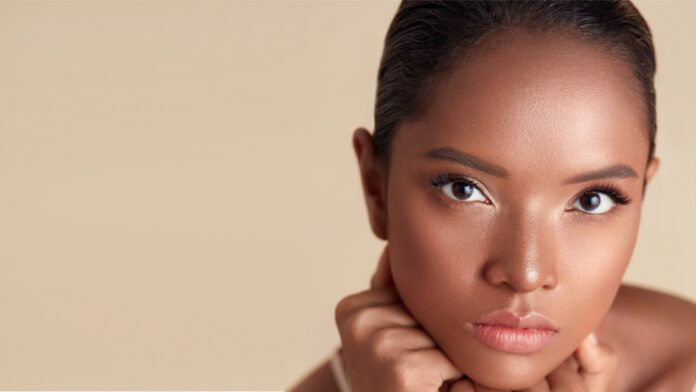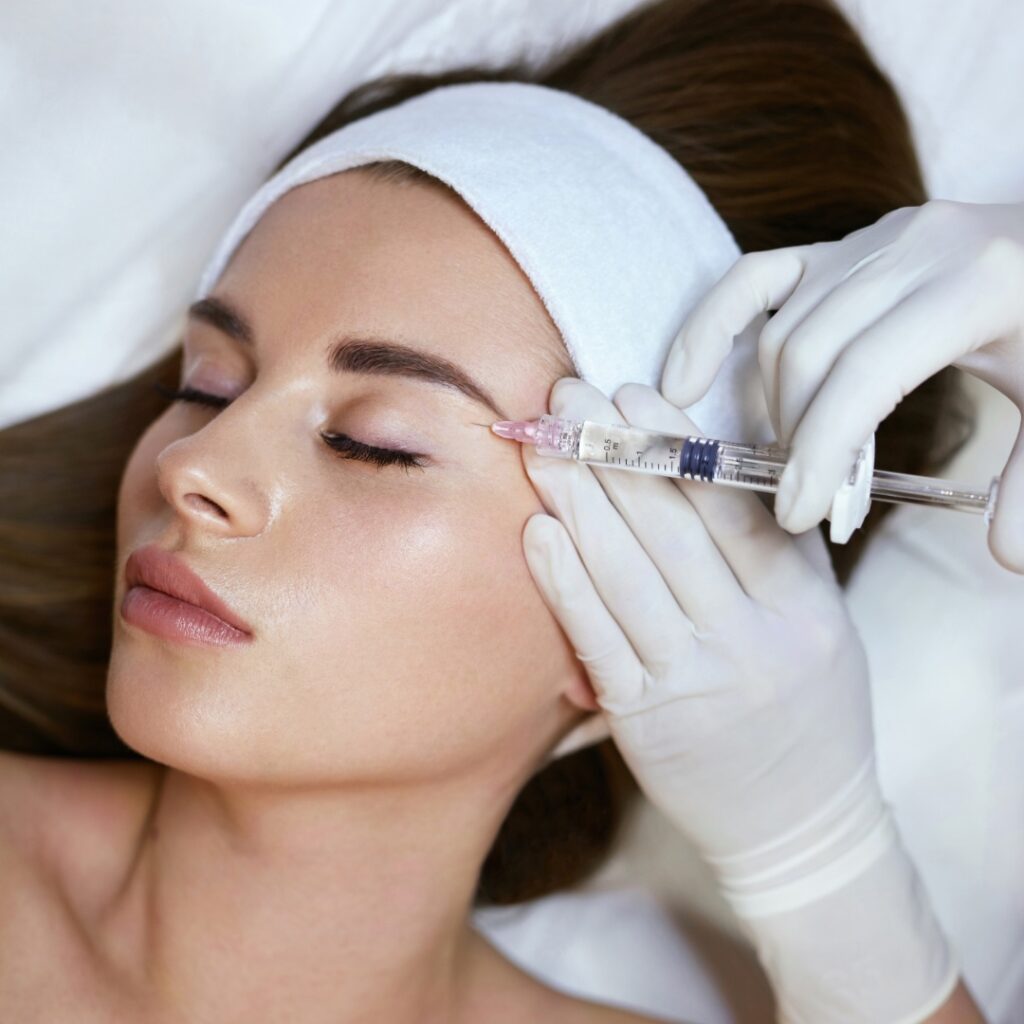2021 has been an interesting one. Alongside changes in how we work and socialise, aesthetic practitioners have also seen rising demand for cosmetic treatments and ‘tweakments’. Here’s the 2022 guide to the most popular non-surgical cosmetic procedures.
Anti-wrinkle injections
- Smooths away dynamic lines such as crow’s feet, forehead lines and the “11’s” between the eyes
- Subtle brow lift effect
- Jawline slimming
Known under the brand names Botox, Dysport and Xeomin, botulinum toxin is single-handedly the most popular aesthetic treatment. Botulinum toxin works by blocking nerve stimulation to wrinkle-causing muscles, which prevents the muscle from contracting and smooths away wrinkles and fine lines.
As a muscle relaxant, it is used to treat crow’s feet around the eyes, the frown lines between the eyebrows (glabellar lines) and the worry lines across the forehead. It can also be used to produce the effect of a brow lift by relaxing the muscles that drag down the brow. It can also be used (off label) in the masseter muscle to create a slimmer-looking jawline.
A few tiny injections are administered just under the skin and the results kick in around Day 4 or 5, reaching their full result around 2 weeks and lasting on average for about 4 months. The procedure usually takes about 10 minutes and is generally well tolerated.
Fillers
- Used to add volume to cheeks, midface, temple hollows and lips
- Fills in static lines, wrinkles, depressions and scars
Fillers are used to add volume and structure, fill deep folds and smooth fine lines and wrinkles. There are different grades of fillers designed specifically for use in different parts of the face and for different purposes – from creating fuller lips to revolumising sagging cheeks to filling in hollowing temples. Fillers can be injected superficially to add volume to lips, fill in fine lines or reduce under-eye circles and hollows. They can also be used more deeply to ‘sculpt’ the face and add contour, projection and definition to areas such as the cheeks, chin, jawline and even the nose.
Today’s fillers vary in longevity, composition and viscosity, depending on what and where is being treated, but all are gel-like in consistency and use a substance called hyaluronic acid, which is found naturally in the body and can absorb up to 1,000 times its own weight in water. The type of filler (composition and viscosity), where it’s used and the depth of injection all influence the final result, and how long they last. Superficial ‘soft’ injections for lips, for example, may last up to 6 months, while firmer filler designed for building and contouring and injected deep on the bone can last 12-18 months.
There’s some discomfort associated with filler injections but a topical anaesthetic should help keep you comfortable. Depending on the amount of areas, this type of procedure will take anywhere from 15 minutes to an hour on average.
Skin tightening / lifting
- Non-surgical face lift effect
- Tightening lax skin
Energy-based treatments for facial lifting and skin tightening are increasingly popular. These devices commonly use a form of energy such as radiofrequency or ultrasound waves – to target deeper levels of the dermis and promote the production of new collagen formation and remodelling. This improves skin texture and reduces sagging skin, as well as improving drooping eyes, jaw line and neck, and softening wrinkles around the mouth, eyes and forehead.
Non-surgical skin tightening treatments heat the skin’s deep dermis and subdermal layers without damaging the outer layers of the skin.
There may be some swelling and redness that gradually subside over the next few days but
in general most patients experience little or no downtime. Results are usually gradual, as the new collagen forms over the next couple of months, and are typically long lasting – up to two years in many cases.
Skin needling
- Overall skin rejuvenation
- Acne and other scarring
- Pore size reduction, textural improvements
Skin needling, or micro-needling, is a treatment used to improve the appearance of wrinkles, scars, stretch marks, skin texture and premature ageing by creating tiny punctures in the skin. The treatment achieves a controlled injury to the skin, which stimulates the skin’s natural growth of healthy new skin. The epidermis is left primarily intact so the healing period is quick – which makes it an effective laser or chemical peel alternative for many.
Skin needling can be performed alone, usually with a roller embedded with medical-grade sterile micro-needles. For more dramatic lifting and toning results, radiofrequency (RF) micro-needling devices combine the collagen-boosting, skin resurfacing effect of skin needling with the skin-tightening technology of RF energy.
After treatment, the skin is red and swollen for around one to two days, with a light graze- like scabbing effect forming over the treated area on day two of recovery. Most patients are able to return to work and normal activities within 48 hours of treatment.
Multiple treatments are usually necessary to achieve significant improvement in the appearance and depth of lines and scars. Treatment effects are cumulative and can be seen six to eight weeks after the initial treatment with long-lasting results.
Lasers
- Overall skin rejuvenation
- Sun damage, scarring, lines and wrinkles, anti-ageing, pigmentation
Laser therapies work by targeting tissue and can be used for a number of treatments, including pigmentation, scarring, unwanted hair, spider veins, sun-damaged skin, and wrinkle reduction.
Advances in laser technology mean that laser skin resurfacing, once reserved for the treatment of severe conditions such as acne scarring due to the extensive downtime involved, has become an effective option for many people seeking reduction of lines and wrinkles and correction of pigmentation.
Most resurfacing lasers work by removing microscopic quantities and stimulating the production of new collagen in the skin. The advent of fractionated laser technology, where microscopic columns of skin are treated while surrounding skin is left intact, has made it possible to achieve better
results with fewer side effects. Fractionated technology has been applied to the CO2 laser, dramatically reducing the recovery time. Results and downtime for all laser treatments vary depending on the depth and strength of treatment.
Thread lifts
- Face lift effect
- Skin revitalisation
Thread lifts have all but taken over Instagram in the past couple of years, with many pundits speculating thread lifts are the secret trend behind the ubiquitous “IG face”.
Thread lifting is a minimally invasive procedure that elevates the soft tissues of the face using specially designed internal sutures and can deliver dramatic results that can almost rival a surgical facelift for the right candidate.
The procedure involves the use of multiple fine biocompatible threads to lift and support skin and tissues on the face (usually mid face) and neck. By inserting threads into the cheek area, not only can the cheek be suspended to a higher position, but collagen production can also be stimulated, thus improving the hydration, tone and texture of the skin.
The threads dissolve within around nine to 12 months, whilst maintaining the revitalising and lifting effect for around 2 years. Thread lifts are performed under local anaesthetic and usually take around one hour. While there may be some visible swelling and bruising, you can go back to work right away if you’d like.
Depending on the thread, results are immediately apparent, but you should notice further improvement in the days and weeks following, as swelling and bruising starts to subside. [A]A













